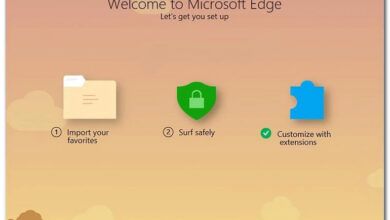Microsoft Edge Error ‘Can’t connect securely to this page’ [Fixed]
Microsoft Edge is a browser that is way more advanced and better in functionality than the Internet Explorer which it replaced in Windows 10. Even though Internet Explorer still exists in today’s Windows 10, Edge is now the default browser. The browser has been here for quite a while now and it gets better and better with every update issued for it. However, it has quite a few issues, one of them being the ‘Can’t connect securely to this page’ error message while trying to connect to an HTTPS website. This is often due to the TLS encryption settings, though, that’s not it. It can be caused by several other reasons that we are going to mention down below. 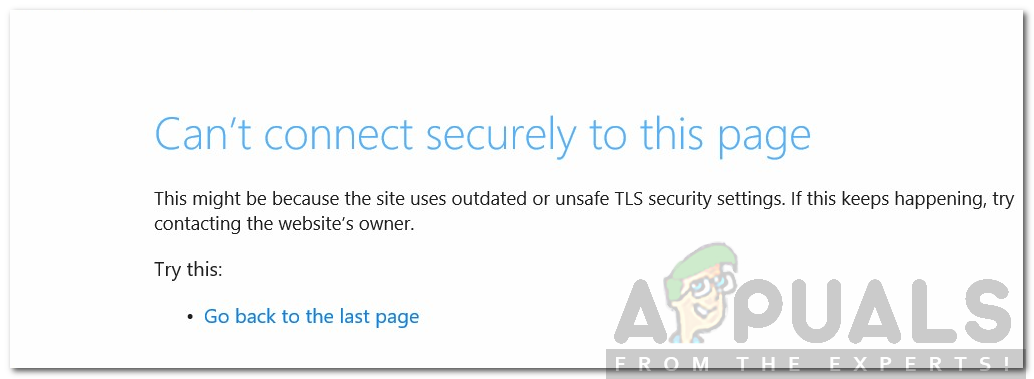
Therefore, let us get into the real stuff and start by mentioning the causes of the error message and then providing the solutions afterward.
What causes Microsoft Edge to give ‘Can’t Connect Securely to this Page’ Error Message?
When a browser tries to connect to an HTTPS website, it relies on the TLS handshakes between the browser and the server. HTTPS (Secured hypertext transfer protocol), as opposed to HTTP, is a secure form of communication between the web server and the browser since all the data that flows through it is encrypted and can’t be read by someone else. Let’s go through the causes of this error coming in Microsoft Edge.
- Different version of TLS encryption used in Microsoft Edge: The main cause of this error coming in Microsoft edge is that it has been configured to use TLS encryption settings which mismatch with the server. There are usually some old websites lying around on the internet that often do not get updated and the TLS encryption version that they use is older than the one used in Microsoft Edge.
- Disabled TLS version 1.2 in Microsoft Windows: If you have disabled the TLS encryption version 1.2 in Microsoft Windows then you might not be able to access those websites which use TLS version 1.2 as their encryption type as your computer wouldn’t be able to decrypt it and there would be no communication possible between you and the website server.
- Website having mixed HTTP and HTTPS content: Another reason can be that the website you are trying to access is having content of mixed nature, i.e HTTP and HTTPS. So, at times, this can be problematic for the browser and your Microsoft Edge will throw this error.
- Weak MD5/3DES encryption algorithms have been disabled by the Administrator: Another thing that can be causing this error is that you or the system administrator has disabled the use of weak MD5 Algorithms and thus, you are not being able to access websites using HTTPS.
To resolve your issue, please go through the solutions given down below.
Solution 1: Accept old TLS encryption settings (1.0, 1.1 and 1.2)
The first workaround is that you have to accept the TLS 1.0 and 1.1 encryption settings in your Windows. It is also possible that the website you are trying to access uses the TLS 1.2 encryption and you don’t have it enabled in your Windows. Therefore, what you need to do is to check the TLS 1.2 in your Internet Options settings in Windows. Doing that is very simple.
- Click on Start Menu then type Internet Options and open “Internet Options”.
- Then go to the Advanced Tab in it and check the “TLS 1.0”, “TLS 1.1” and “TLS 1.2” checkboxes in the Settings section of it.
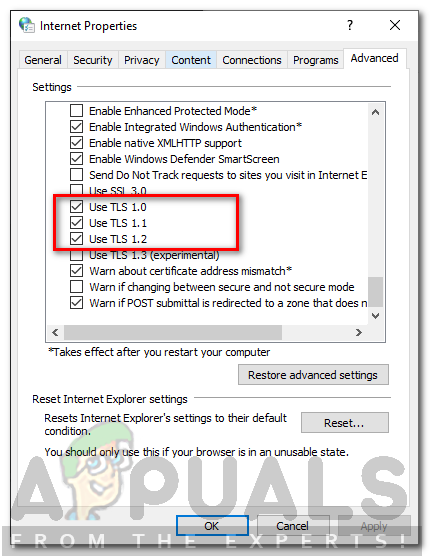
Allowing Use of TLS 1.0, 1.1 and 1.2 - Also, make sure that the “Use SSL 3.0” box is unchecked as it has been known to cause problems and may make things worse instead.
- Click “OK” to apply changes and then check your browser again. Hopefully, the website which was giving you that problem will load now.
Solution 2: Enable Display Mixed Content in Internet Security Settings
Now another thing you can do is to enable the display of mixed content “HTTP along with HTTPS” in the Windows Internet Security Settings. As we have mentioned earlier, websites using HTTPS and having HTTP content in it too will have problems in working as the two are very different ways of communication. Thus, if you are visiting websites that use HTTP along with HTTPS, you have to enable the display mixed content option, otherwise, they won’t load properly. To do that, follow the given steps:
- Type Internet Options in the Start Menu.
- Then go to Security Tab.
- Afterward, select the “Internet” or the globe icon and click Custom level.
- Then a new window will open with the Security Settings options in it.
- Scroll down until you see the text Display Mixed Content.
- Check the option Enable below it.
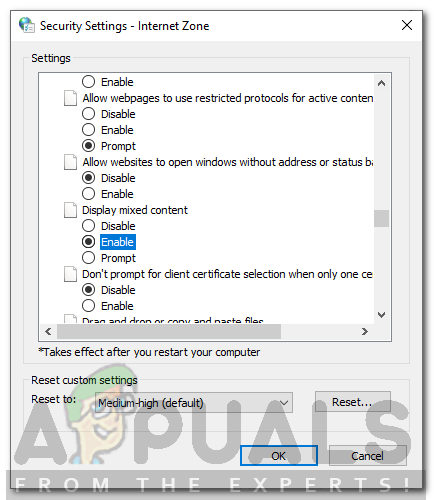
Enabling Display of Mixed Content - Click OK to exit out of this window and OK again to exit the Internet Options.
Hopefully, after doing that, you will be able to visit HTTPS websites again in Microsoft Edge.
Solution 3: Resetting Browser Data and Cache
If none of the above methods work, it probably means that there is corrupt/unwanted data present in your browser which is conflicting with its operations. This is a very common problem with Microsoft Edge for quite some time and is usually resolved after clearing the data in it. Do note that this method will erase all of your history, bookmarks, and other preferences stored in your browser so make sure that you back them up before proceeding.
- Open Microsoft Edge in your browser and once inside, click on the three horizontal dots present at the top-right side of the screen.
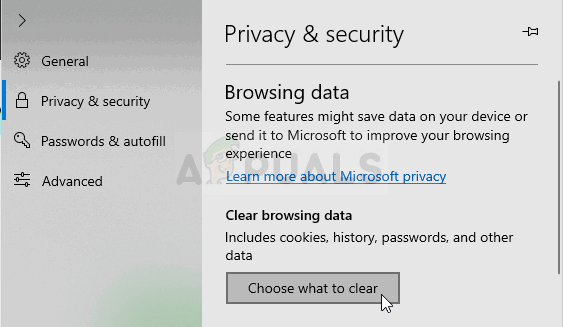
Clear browsing data in Microsoft Edge - Now, click on Settings and after navigating to the Clear browsing data section, make sure you clear all cache and other data.
- Save changes and exit. Restart your computer and then check if the issue is resolved for good.
Solution 4: Changing DNS Address
DNS (Domain Name System) is one of the most important components in communicating over the internet. They resolve the name addresses into IP addresses and then forward the request. DNS addresses are usually set to default which is connected to the address which is set to your ISP’s default address.

You should change your DNS address to Google’s address and then check if the error message still appears. If it doesn’t occur again, you can keep using Google’s DNS. It is just as fast as the normal servers and has almost 100% up-time.




